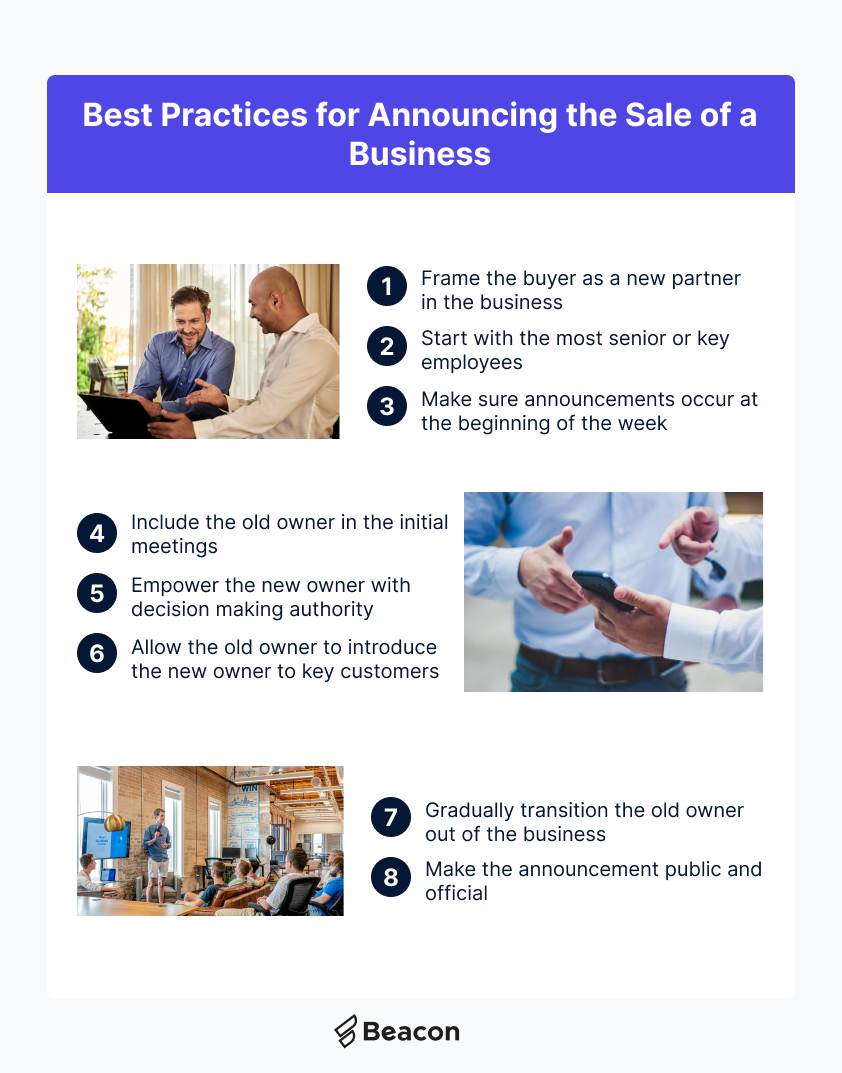Explore your options
Get a 100% confidential and complimentary business valuation.
Upon closing of a small business sale, one of the first steps is to announce the sale publicly. Given that most transactions are confidential, this is often the first time employees, customers, suppliers and partners are hearing about the business being sold.
While both the buyer and seller of the business are likely excited that the negotiations and legal paperwork are finished, it’s important for both to be thoughtful when announcing the sale. It’s an opportunity to assure employees, show customers buy-in from the previous owner, and position the new owner for success.
On the flip side, it’s also an opportunity for things to go south. The employees may be spooked and worried that they no longer have a job. Customers may question the ability of the new owner to provide the same level of care and service that the previous owner did.
Given all of the small business transactions that we see at Beacon, here are the best practices we recommend when announcing the sale of a business:

1. Frame the buyer as a new partner in the business
Rather than framing the buyer as the new owner off the bat, we suggest that the old owner introduce the buyer as a new partner in the business.
Given there is typically at least a 30-day transition period and most transactions include seller financing, a buyer and seller truly are partners in the business for some time after closing.
Framing the buyer as a partner achieves two goals: (1) it shows stability to employees and customers, as the old owner is still involved, (2) it allows the buyer time to build relationships with employees and customers before the old owner is gone.
2. Start with the most senior or key employees
Before announcing the new partner to the entire team, it’s best to start with the most senior or key employees. By giving them a heads-up, two things occur.
First, they feel like they are being recognized for their seniority and the value they bring to the business, as they’re getting told before others.
Second, many junior employees look to the senior employees for how to react to news. By telling the key employees first, they will be able to show support and assurance to more junior employees when the entire company is told.
3. Make sure announcements occur at the beginning of the week
Once the key employees are brought in and made aware of the transaction, the next step is to announce to the broader team. We always recommend that announcements occur during the beginning of the week.
This ensures that employees have time to digest the news, see that it’s still business-as-usual, and ask any lingering questions to the old or new owner before the weekend comes around.
Announcing on Friday’s is the worst timing, in our opinion. It does not allow the employees time to digest the news and see that things are going to be fine. Instead, they immediately head off into the weekend worried about their job security and the future of the company.
4. Include the old owner in the initial meeting
Throughout the announcement period, we highly recommend including the seller in as many meetings as possible. By doing this, the old owner is implicitly showing his support for the buyer and ensuring success of the transition.
5. Prioritize empowering the new owner with decision making authority
We recommend that the old owner empower the new owner immediately. By showing support for the new owner, other employees will start to think of him or her as their boss and respect his or her authority.
This will prevent issues from occurring once the old owner transitions out, such as immediately asking for raises or questioning the new owner’s authority.
6. Allow the old owner to introduce the new owner to key customers
Before the sale is fully announced and the seller transitions out, it’s important to take time to meet the key customers. By prioritizing them, you get similar benefits as with focusing on key employees first.
The retiring owner can make sure to show his or her stamp of approval on their new partner. Given the cult of personality around many business owners, it’s important that customers see that the retiring owner trusts the buyer and assures them that the buyer is well suited to serve their needs.
7. Gradually transition the old owner out of the business
After the first week or two, the buyer can start to take over roles and responsibilities from the seller. This can start by owning scheduling or dispatching and gradually progress to holding the first staff meetings without the old owner.
8. Make the announcement public and official
After the first few weeks, it’s time to announce the sale to the public. By this point, it’s been made clear to employees and existing customers that the retiring owner trusts the buyer and will be around to support him or her in their business journey.
During the public announcement, buyers will often update their website as well as social media accounts across Facebook and LinkedIn. They may even create posts announcing the new ownership and giving a shout out to the previous owner, thanking him or her for their support and help getting started.
Explore your options
Get a 100% confidential and complimentary business valuation.

John takes a personal approach when advising buyers and sellers on taking the next step. John has deep knowledge of a variety of markets through his background as a member of the Chicago Board of Trade and experience as a licensed real estate agent in Texas and Michigan. Originally from Detroit, John's passion for automotive runs as deeply as his love of Wolverine Football.
Information posted on this page is not intended to be, and should not be construed as tax, legal, investment or accounting advice. You should consult your own tax, legal, investment and accounting advisors before engaging in any transaction.

Calder Capital

Sam Domino


